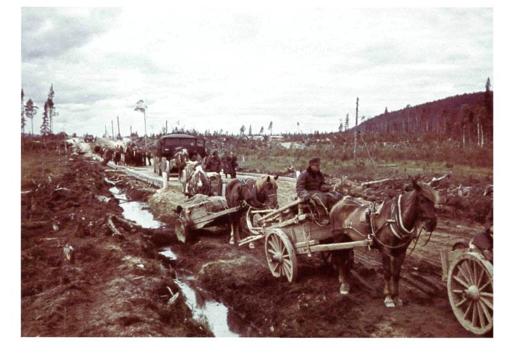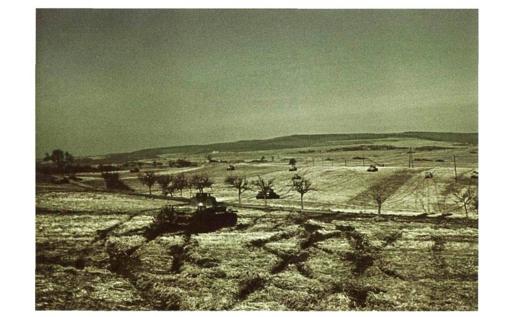The World at War (36 page)
Authors: Richard Holmes

Normandy 22 July 1944 – Churchill with Montgomery, Lieutenant General Guy Simmonds of II Canadian Corps (left) and Lieutenant General Sir Miles Dempsey of British Second Army (
rear).

The Battle of Britain, 1940: the workhorse Hawker Hurricane
(foreground, above)
attacked bombers such as the Junkers 88 (below); while the Supermarine Spitfires
(background, above)
took on the escorting Messerschmitt 109s
(below).


Barbarossa, 1941 – devastation for the Byelorussian peasantry.

While the German mechanised spearheads clattered on ahead the bulk of the army followed on foot and most supply columns were still horse drawn, like this one near Leningrad, autumn 1941.

Mud slowed the German offensive of 1941 and winter brought it to a grinding halt. The flag is for aerial recognition, not patriotic fervour.

would attack Midway, therefore the United States was ready and waiting. And we got trapped in the net. The biggest reason for the failure was that the secret leaked. The Americans had obtained Japan's secret code in
Guadalcanal – no, in the Solomons or somewhere like that – salvaging it from a sunken Japanese ship. After Midway we won and lost some engagements but we didn't win as many as before and the defeats began to outnumber the victories. Therefore Midway was the turning point.
MARQUIS KOICHI KIDO
Lord Keeper of the Privy Seal
I guess it was from the Midway naval battle. In that battle Japan lost four large aircraft carriers; this tilted the naval battle against Japan. From then on Japan was on the defensive, therefore I think the Midway battle was the turning point.
RICHARD TREGASKIS
War correspondent, Guadalcanal
All the Pacific fighting was bitter, really, because the Japanese were in a kind of suicidal attempt to hang on, but the thing about Guadalcanal that was really bitter was that this was the whole strength we had. We had such a tiny fraction of America's forces, money and man-power resources. Ninety per cent went to Europe and we had such a tiny little thread of existence down there. It was our first offensive in the Pacific and we went in with only one division and no air power – except the Navy supplied some air power when we went in – but for a long time we had no air power so that the desperate thing was that we had so little to work with. When I was there only a few days – I was one of the first people to come ashore at Guadalcanal – we'd had some desperate battles and we had lost four cruisers, one of them the
Canberra,
the Australian cruiser, so it was very discouraging and all the ships were leaving. Landing-force commander General Alexander Vandergrift called me in and said, 'A lot of people are saying this may be another Bataan and now is probably the last chance you'll have to leave.' And so I thought and thought and struggled with my conscience, such as it is, and eventually after watching the ships leave one by one decided to stay.
TOSHIKAZU KASE
When our Army begun to suffer at Guadalcanal, and the Navy at Midway, I thought the time had arrived for preparations for an early termination of hostilities. I thought I had to evade the Military Police and to see the movement, and effort, in utmost secrecy, even at the Foreign Office. The group formed to prepare for this movement included the Private Secretary to one of the key members of the High Command in shaping military operations plan, and he was at one time Private Secretary to General Tojo as War Minister, so he was in the know about the intentions of the Army High Command.
RICHARD TREGASKIS
I think the salvation of the Guadalcanal campaign is in an anecdote about probably the greatest single hero of Guadalcanal, Lieutenant Colonel
Merritt Edson. He was the head of the 1st Marine Raiders and they say about Red Mike that he had every medal the Marine Corps could give except the Purple Heart and that was the one he deserved most. He had never been wounded and never was till he died. But he was very smart and stubborn and clever. When he was summoned to consult about the situation, General Vandergrift didn't believe the Lunga Ridge would be attacked but Edson said this is where the Japanese will attack, this is their first major attack, and that's where they came. Red Mike had only the remnants at that point of his 1st Raider Battalion and the 1st Parachute Battalion, which had been through the worst of the Guadalcanal fighting to that point. And it so happened that this main attack by the Japanese came right through his bivouac where he was with his troops, who were supposed to be resting. And so they drove right through them and those people hung on and Red Mike went around and personally talked to all these guys who were falling back and he would say to them, 'The only difference between you and a good marine is you're going in the wrong direction.' So he held that whole business together and held that ridge until some supporting troops came up. But the main point of this dramatic episode is that it shows how on Guadalcanal there never was enough and what we had was so badly shot up that it was only through miracles that they could survive. Just nerve and, well, guts.
*30
MAJOR GENERAL J LAWTON COLLINS
Commander 25th Infantry Division, Guadalcanal
My division was sent down from Hawaii to go into Guadalcanal to relieve the 1st Marine Division and another Army division that had established a bridgehead on Guadalcanal, having driven off the Japs – killed off a good many of them. But a stalemate had developed and Admiral Richmond Turner, who was in command down in that area, wanted my division turned in to Guadalcanal to lead the offensive of the 14th Army Corps to break out of this stalemate, which we did.
LIEUTENANT COLONEL ICHII SUGITA
Japanese Army
Before the beginning of the war, I felt by myself that the war against America and England would be a very hard war, but I went to Guadalcanal and I found out that the tide had turned against us, especially after the failure to attack at the aerodrome in Guadalcanal on 24th or 25th October.
MAJOR GENERAL COLLINS
It was jungle fighting, but not entirely because Guadalcanal is a rather rough volcanic island and the ridges were covered normally with tall grass that grew eight or ten feet tall. In the earlier fighting by the Marines and the Army Division there, this grass has been burnt off so the ridge lines were clear and the jungle was down in the valleys, very heavy. But in my attack, which was designed to envelop the south flank of the Japanese position there, we stuck to the ridge lines so our troops in the initial fighting went along the ridges in relatively open country. It was very tough fighting because these ridges were not very broad and furthermore the Japanese were tough fighters and they never would give up. We had isolated a Japanese regiment as a strong point and they fought until we actually had to annihilate them. We used loudspeakers after we had surrounded them and tried to persuade them to surrender but they wouldn't. They were gallant fellows, no question. Not very skilful at times, but tough fighters and this made it difficult.
ROBERT SHERROD
War correspondent
Nimitz was a much quieter man who had a great deal more strength than MacArthur. He was much stronger and better prepared for war, and the Pacific was essentially a naval war, you can't get away from that. MacArthur tried to pretend that it was not mostly a Navy war and it made for a great deal of conflict during the war. Sometimes there was overlapping. Once during, I think it was the invasion of Leyte, we caught ten Japanese destroyers and both of them put out communiqués on it. MacArthur simply said yes, we sank them all, and then we [Nimitz's staff] said we sank six and damaged four, which was correct of course. It was like MacArthur was determined to beat Nimitz with his communiqué; he'd sink to such petty things as that.
MAJOR GENERAL COLLINS
MacArthur had practically no troops when he withdrew from the Philippines. He went down to Australia and the fighting was initiated by Admiral Nimitz from Hawaii. We went up the islands leading to New Guinea and this could better be controlled under naval command, that is unified command with a naval commander, and he had the airmen and the army troops under Ms control. So we had unified command in the initial phases. Then when MacArthur began to come in later, in the drive to the north from Australia, he ran the show in the western part of the Pacific. Admiral Nimitz was a very able man and a very wonderful chap personally, no problem getting along with Admiral Nimitz. And the same was true with admirals Halsey and Sprague and the other naval people. I was not under MacArthur's command but there was no difficulty that developed as far as I know. I think that it worked out quite satisfactorily, the coordination. By the time the latter part of the fighting was on, I was in Europe, so I had no personal experience in this regard.
